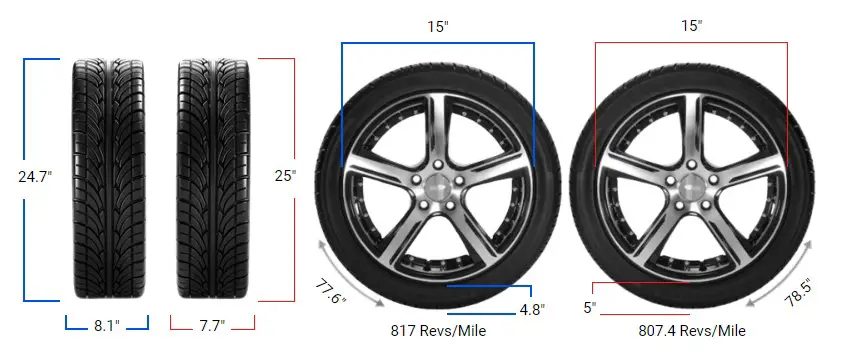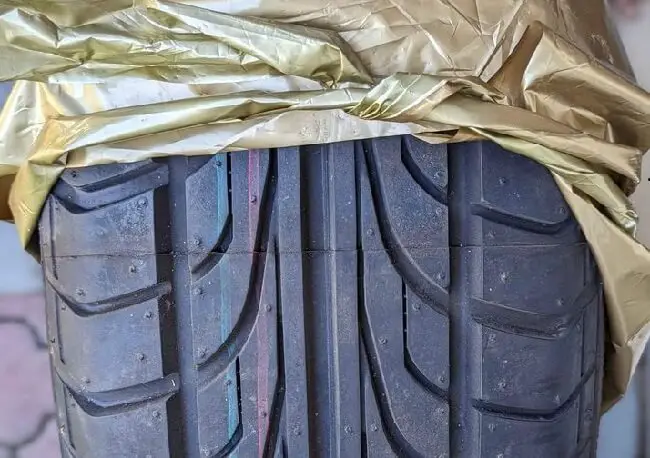Tire Size 205/60r15 vs 195/65r15

Are you considering switching from 205/60R15 to 195/65R15 tires on your vehicle? It’s important to understand the differences between these tire sizes and how they may impact your driving experience.
While the 1.2% diameter difference falls within the acceptable range of ±3%, there are still some factors to consider before making the switch.
- The new tires will be 0.39 inches (10 mm) narrower
- Sidewall height will increase by 0.15 inches (3.75 mm)
- Speedometer readings will be slightly affected, showing 20.24 mph at an actual speed of 20 mph
- On-road and off-road performance may be impacted in minor ways
205/60r15 vs 195/65r15 Table
The primary difference between 205/60R15 and 195/65R15 tires is the width. The new 195/65R15 tires will be 0.39 inches (10 mm) narrower than the original 205/60R15 tires.

Fitment Guide
It’s crucial to ensure that the diameter difference falls within the acceptable range of 3%. In this case, the diameter difference between 205/60R15 and 195/65R15 tires is 1.2%, which is well within the acceptable limits.
This means that you can safely switch to 195/65R15 tires without needing any major adaptations to your vehicle.
On-Road Impact
Switching to 195/65R15 tires can have some minor effects on your vehicle’s on-road performance. Here are some aspects to consider:
- Speedometer Accuracy: Due to the slight difference in tire diameter, your speedometer readings will be minimally affected. At a speedometer reading of 20 mph, your actual speed will be 20.24 mph. This difference is negligible and unlikely to cause any issues in day-to-day driving.
- Ride Comfort: The taller sidewall of the 195/65R15 tires may provide a slightly softer ride compared to the 205/60R15 tires. The extra 0.15 inches (3.75 mm) of sidewall height can help absorb bumps and vibrations, potentially enhancing overall ride comfort.
- Fuel Efficiency: The narrower width of the 195/65R15 tires may slightly improve your vehicle’s fuel efficiency. Narrower tires have a smaller contact patch with the road, reducing rolling resistance and potentially leading to a minor increase in gas mileage.
- Handling: The narrower width of the 195/65R15 tires may result in a small reduction in handling performance, particularly during fast cornering or aggressive maneuvers. However, for most daily driving situations, this difference will be barely noticeable.

Off-Road Impact
If you occasionally take your vehicle off-road, switching to 195/65R15 tires may have some minor effects on performance:
- Ground Clearance: The taller sidewall of the 195/65R15 tires will slightly increase your vehicle’s ground clearance by 0.15 inches (3.75 mm). This can be beneficial when navigating rough terrain or obstacles, providing a bit more room between the ground and your vehicle’s undercarriage.
- Traction: The narrower width of the 195/65R15 tires may provide slightly less traction in loose or slippery off-road conditions compared to the wider 205/60R15 tires. However, the difference is likely to be minimal and may not be noticeable in most off-road situations.
- Durability: The taller sidewall of the 195/65R15 tires may offer a bit more protection against sidewall damage when encountering rocks, roots, or other off-road hazards. The extra sidewall height can help absorb impacts and reduce the risk of punctures or cuts.

What is the Difference Between 205/60R15 and 195/65R15?
The main difference between 205/60R15 and 195/65R15 tires is the width. The 205/60R15 tire is 0.39 inches (10 mm) wider than the 195/65R15 tire.
This difference in width can affect the tire’s contact patch with the road, which may impact handling, traction, and overall performance.
The 195/65R15 tire also has a slightly taller sidewall, with a difference of 0.15 inches (3.75 mm) compared to the 205/60R15 tire.
Can I Use 195/65R15 Instead of 205/60R15?
Yes, you can use 195/65R15 tires instead of 205/60R15 tires. The overall diameter difference between these two sizes is approximately 0.3 inches (7.5 mm) or 1.2%, which falls within the generally accepted range of 3%.
This means that switching from 205/60R15 to 195/65R15 tires should not cause any significant issues with your vehicle’s performance, handling, or safety.

How Much Taller Is a 195/65R15 Tire Than a 205/60R15?
A 195/65R15 tire is approximately 0.3 inches (7.5 mm) taller than a 205/60R15 tire. The overall diameter of the 195/65R15 tire is 24.98 inches (634.5 mm), while the 205/60R15 tire has a diameter of 24.69 inches (627 mm).
This difference in height is relatively small and should not significantly impact the vehicle’s performance or handling.
How Much Wider is a 205/60R15 Tire Than a 195/65R15?
A 205/60R15 tire is approximately 0.39 inches (10 mm) wider than a 195/65R15 tire. The width of the 205/60R15 tire is 8.07 inches (205 mm), while the width of the 195/65R15 tire is 7.68 inches (195 mm).
This difference in width can affect the tire’s contact patch with the road, potentially impacting handling, traction, and overall performance.
Our Observations
After analyzing the differences between 205/60R15 and 195/65R15 tires, we’ve concluded that switching to the new tire size is a viable option for most drivers. The 1.2% diameter difference falls well within the acceptable range, meaning no major adaptations to your vehicle are necessary.
The main benefits of switching to 195/65R15 tires include a potentially softer ride, slightly improved fuel efficiency, and a minor increase in ground clearance for off-road use. However, it’s important to note that the narrower width may result in a small reduction in handling performance and traction in certain situations.
Overall, the differences between these tire sizes are relatively minor and unlikely to significantly impact your daily driving experience. Both on-road and off-road, the changes in performance will be subtle and may not be noticeable to most drivers.
If you’re considering switching from 205/60R15 to 195/65R15 tires, rest assured that the differences are within acceptable limits and should not cause any major issues with your vehicle’s performance or safety. As always, it’s essential to maintain proper tire pressure, rotate your tires regularly, and replace them when necessary to ensure optimal performance and longevity.

Meet Caitlin McCormack, a Tire Size Expert and Blogger Passionate About Everything Related to Tires. With Years of Experience in the Tire Industry, Caitlin Has Become an Expert in Tire Sizes and Their Impact on Vehicle Performance.
